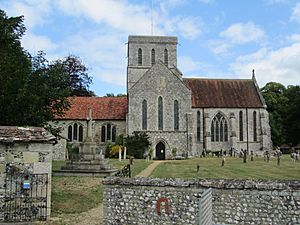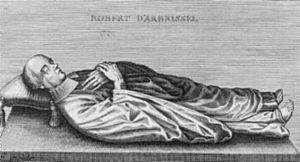Amesbury Abbey facts for kids
Amesbury Abbey was once a special place for religious women, called Benedictine nuns, in Amesbury, Wiltshire, England. It was started by Queen Ælfthryth around the year 979. This may have been where an even older religious building once stood.
Later, in 1177, King Henry II closed down this first abbey. In its place, he started a new religious house for a different group of nuns, called the Order of Fontevraud. This new place became known as Amesbury Priory.
Today, the name Amesbury Abbey refers to a large, beautiful country house nearby. It was built in the 1830s and is now used as a nursing home. It's a Grade I listed building, meaning it's very important historically.
Contents
History of Amesbury's Religious Houses
Amesbury was a significant place even before Christian times. There are old stories that a monastery was here long before the Danish invasions. Some believe that Queen Ælfthryth chose Amesbury because people already honored St Melor there. St Melor was a young boy who became a martyr. Later stories say some of his special items were brought to Amesbury. The current Amesbury parish church is named after St Melor.
The First Saxon Abbey
Queen Ælfthryth founded the first monastery around 979. She started two religious houses at that time. The other one was in Wherwell in Hampshire.
For a long time, people thought Queen Ælfthryth started these places because she felt bad about the death of Edward the Martyr. However, historians now believe she wasn't directly responsible for his death.
In 1086, when the Domesday Book was written, the abbey owned several manors (large estates) in Wiltshire and Berkshire. These included places like Bulford, Boscombe, and Fawley.
Amesbury Abbey wasn't one of the richest or most important women's monasteries. It often faced problems from powerful neighbors. Its income was less than other nunneries in the area, like Wilton Abbey or Shaftesbury Abbey.
We don't know much about the early leaders, called Abbesses, of Amesbury. We only know of Heahpled before the Norman Conquest and Beatrice when the abbey was refounded in 1177.
King Henry II's New Foundation
In 1177, King Henry II closed Queen Ælfthryth's abbey. He then restarted it as a house for the Order of Fontevraud, which was a different kind of Benedictine group.
Pope Alexander III agreed to this plan in 1176. He said that important bishops should visit the convent and tell the nuns they needed to cooperate. Any nun who didn't want to join the new Order would be moved to another monastery and treated well.
Things didn't go perfectly. It was said that problems were found when the bishops visited in 1177. The Abbess was removed and given a pension. Some other nuns were also asked to leave. It seems all 30 nuns were eventually expelled.
King Henry II then brought about 21 to 24 nuns from Fontevraud Abbey in France. They were led by a former subprioress. Some nuns also came from Westwood Priory, another Fontevraud house. The new community was officially started on May 22, with the King and several bishops present.
The Order of Fontevraud
The Plantagenet kings and queens, like King Henry II, really supported the main Fontevraud Abbey in France. Henry's wife, Eleanor of Aquitaine, even lived there later in life. This monastery, started in 1101, became the burial place for the Plantagenet family.
The Fontevraud Order was special because it had a central leader, just like Cluny Abbey. The head of the Fontevraud Order was always the Abbess of Fontevraud. By the end of the 1100s, she ruled over about 100 smaller houses in France, Spain, and England. These smaller houses were usually called priories, not abbeys, and were led by priors or prioresses.
Fontevraud houses were also often "double monasteries." This meant they had separate areas for both men and women, but they were all under the same leader, usually a prioress. At Amesbury, this system changed over time. By the 1400s, Amesbury seems to have become a house only for women, with a few male priests helping out.
Amesbury Priory: A Royal Connection
King Henry II brought the Fontevraud Order to England. There were only four such houses in the country. Besides Amesbury, they were Westwood Priory, Nuneaton Priory, and Grovebury Priory.
Even though people often call the later Amesbury monastery an "Abbey," it was actually a "Priory." The first monastery was an abbey, but the Fontevraud house was always technically a priory. This is because it was part of a larger order led by the Abbess of Fontevraud.
Important Women at Amesbury Priory
Many important women lived or were buried at Amesbury Priory:
- Eleanor of Brittany (died 1241) was a princess who was held captive for most of her life. She was buried here. Later, King Henry III gave land to the priory to honor her and her brother Arthur.
- Eleanor of Provence, who was Queen to Henry III of England, died in Amesbury in 1291. She was buried in the priory.
- Isabel of Lancaster was the Prioress of Amesbury from about 1343 until her death around 1349. She was the sister of a very important noble, Henry of Grosmont, 1st Duke of Lancaster.
- Not long after, Sybil Montague became prioress in 1391. She was related to powerful families. She tried to get rid of the male leaders at the priory, which caused a big stir and even involved the new king, Henry IV. But Dame Sybil managed to stay in charge until she died in 1420.
The End of the Priory
It's likely that the current Amesbury parish church, the Church of St Mary and St Melor, was once the priory church. This might be why it was saved when King Henry VIII ordered the Dissolution of the Monasteries (when many religious houses were closed down). The church is a Grade I listed building today.
The priory and its other buildings were destroyed. The land was later given to Edward Seymour, 1st Earl of Hertford. He was a nephew of Jane Seymour, who was Queen to King Henry VIII.
The Present-Day Amesbury Abbey House
The large country house called Amesbury Abbey today was not part of the old monastery. It was built between 1834 and 1840 by an architect named Thomas Hopper for Sir Edmund Antrobus. It's made of Chilmark limestone and has three floors.
The house stands in beautiful gardens and parkland, covering about 56 hectares (138 acres). These grounds are also historically important. Today, the house is used as a nursing home. The company that runs it and other similar places also uses the name Amesbury Abbey.




